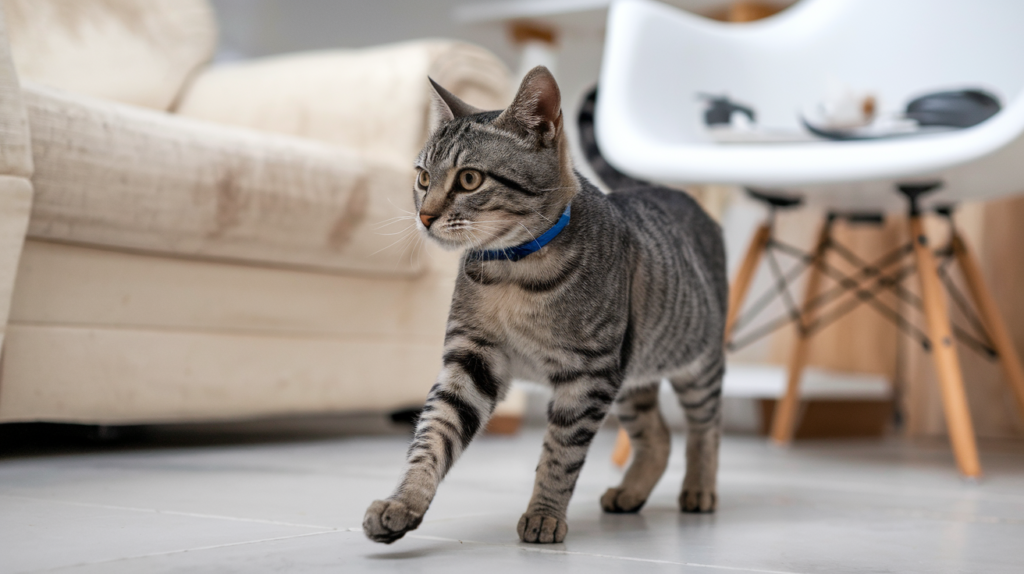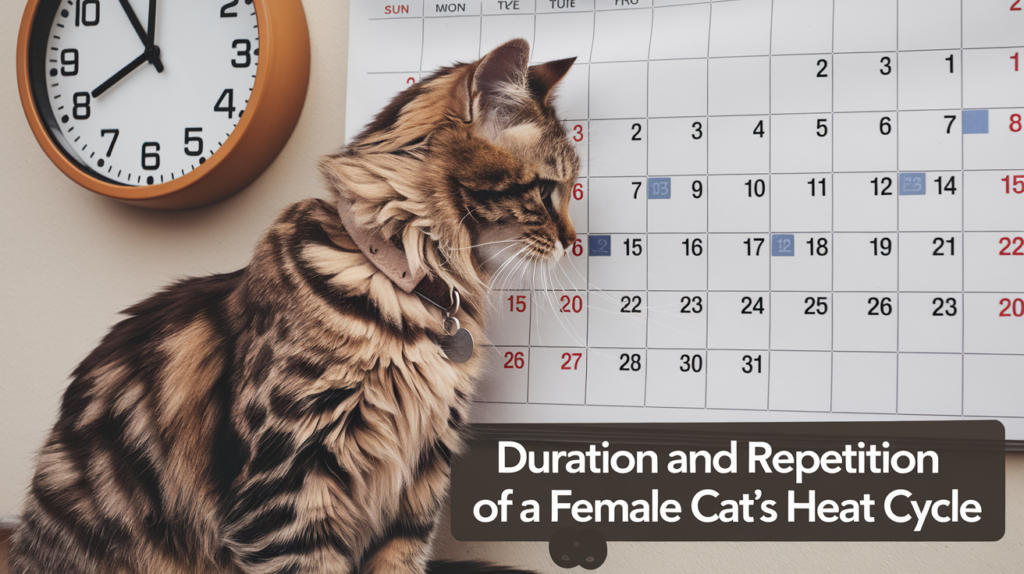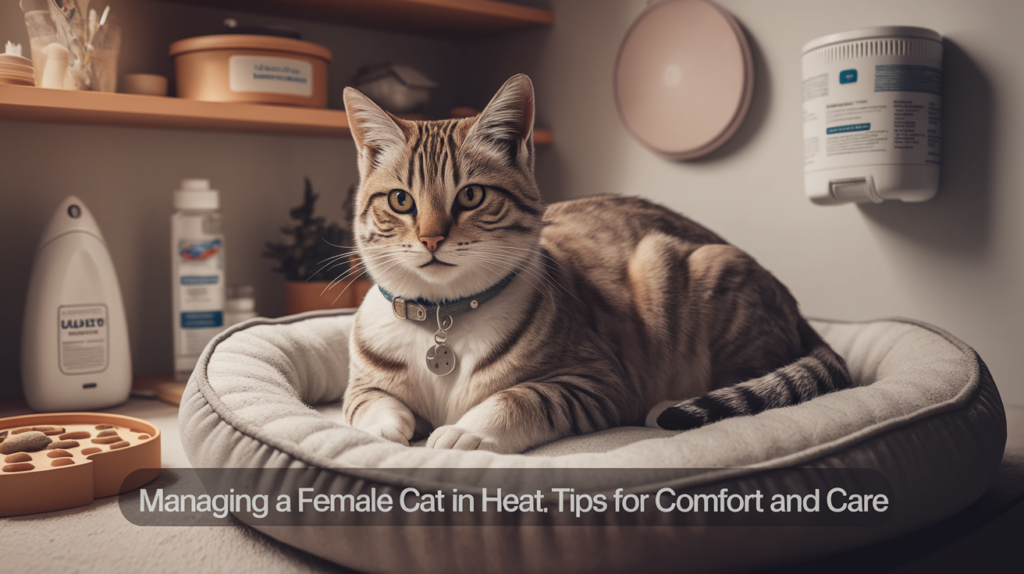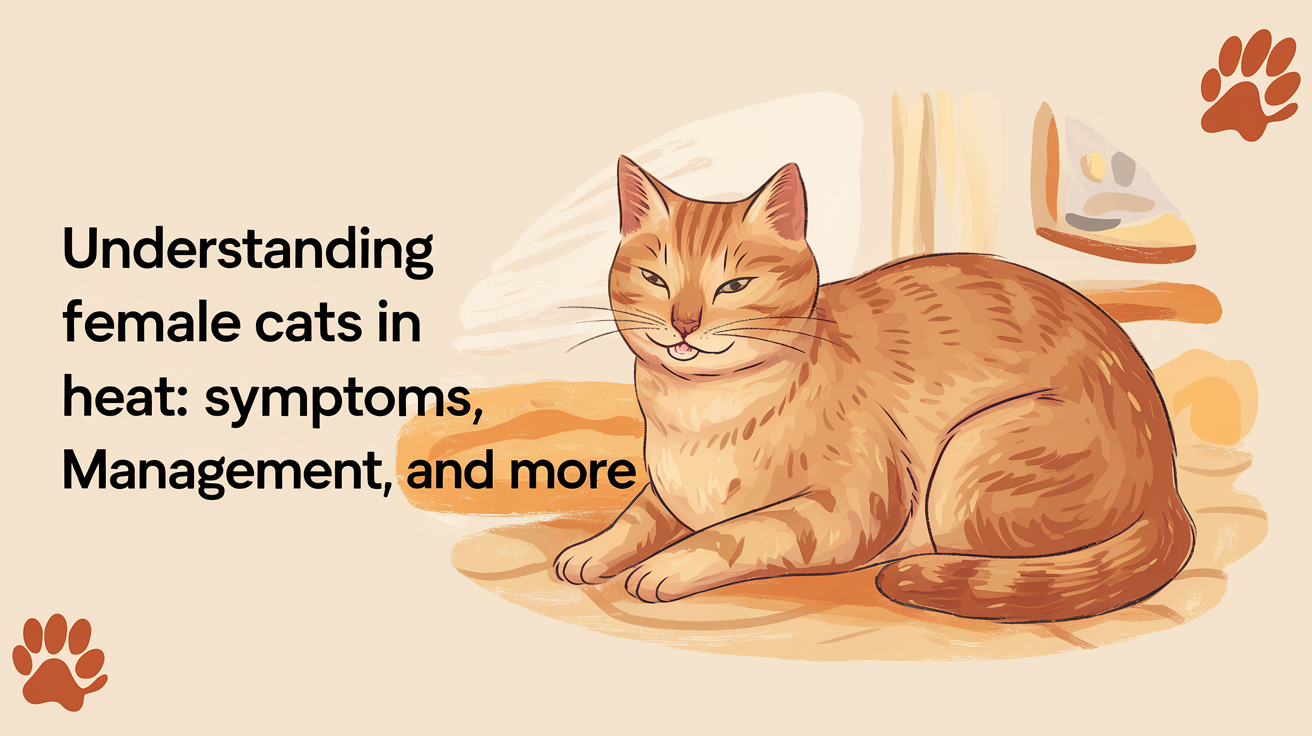Introduction
Female cats’ heat cycle, commonly known as estrus, is a normal aspect of their reproductive system. It begins when a cat reaches sexual maturity, usually between 5 to 10 months of age, depending on the breed. During this period, a female cat becomes fertile and seeks a mate, displaying behaviors that indicate she is in heat. The cycle may recur every several weeks until she becomes pregnant or is spayed. This cycle can be puzzling to pet owners, especially if they are unprepared for the behavioral changes.
Understanding the symptoms of a cat in heat is crucial for both first-time and experienced cat owners. Recognizing the signs early helps in managing the cat’s behavior and making decisions about spaying. Knowing when a cat is in heat can also prevent unwanted pregnancies and reduce stress for both the owner and the pet. By being informed about this natural cycle, owners can better care for their feline companions during these hormonal changes.
What Does It Mean When a Female Cat is in Heat?
When a female cat is in heat, it means she has entered the estrus phase of her reproductive cycle, during which she is fertile and actively seeking a mate. This period is driven by hormones, causing the cat to display noticeable behavioral changes, such as vocalizing loudly, becoming unusually affectionate, or attempting to escape outdoors. The heat cycle is a natural part of a cat’s life, signaling that her body is ready to reproduce. Unlike humans, cats do not experience menstruation; instead, they have distinct phases in their reproductive cycle that repeat regularly if they do not become pregnant.
Most cats experience their first heat cycle between 5 to 10 months of age, though this can vary depending on the breed and individual cat. For example, Siamese cats may go into heat as early as 4 months, while some larger breeds may not have their first heat until closer to a year old. Once a cat begins her heat cycles, they will repeat every 2 to 3 weeks, especially during the warmer months when daylight hours are longer.
The duration of each heat cycle typically lasts anywhere from 3 to 7 days, although it can sometimes be longer if the cat does not mate. If a cat does not become pregnant, the cycle will continue to repeat throughout the breeding season, which in some climates can be almost year-round.
Female cat in heat symptoms
When a female cat enters her heat cycle, her behavior changes significantly, often making it easy to tell when she is in this phase. One of the most noticeable symptoms is increased vocalization. Cats in heat often meow or yowl loudly, sometimes sounding distressed or persistent. This vocalization is a way of signaling to nearby male cats that she is ready to mate. The sounds can be much louder than usual, and they often occur both during the day and at night, which can be disruptive in a quiet household.
Along with vocalization, a cat in heat may show signs of restlessness and anxiety. She may pace around the house, appear agitated, and show little interest in her usual routine. This restlessness often includes attempts to escape outside to find a mate, so owners should be extra cautious about doors and windows during this time. The cat’s anxious behavior can also lead to a lack of sleep or difficulty relaxing, both for the pet and the owner.

Another key symptom is constant attention-seeking behavior. A cat in heat may become unusually affectionate, rubbing against furniture, and people, and even rolling around on the floor. She might follow her owner around more than usual, demanding petting and cuddles. Some cats may also exhibit an odd posture called “lordosis,” where they crouch down with their front legs lowered and rear end raised, often with a twitching tail. This posture signals to male cats that she is ready for mating. Recognizing these symptoms can help owners better understand and manage their cat’s behavior during the heat cycle.
Physical Changes
In addition to behavioral shifts, a female cat in heat will exhibit several physical changes that are linked to her readiness to mate. One of the most common signs is frequent urination and marking territory. During estrus, a cat may urinate more frequently than usual, and in some cases, she may spray urine in different areas of the home. This marking behavior is her way of signaling to male cats that she is fertile and ready to mate. The urine may also carry a stronger scent, which is another cue meant to attract potential mates.
Another noticeable change is a swollen or more prominent genital area. The vulva may become slightly enlarged and more visible during the heat cycle, though this can be a subtle sign that not all owners will notice. This swelling is a direct result of hormonal changes in the cat’s body as she enters her reproductive phase.
Finally, a cat in heat may engage in excessive grooming, particularly around her genital area. This behavior is a response to the increased sensitivity in this region and is another physical indicator of her heat cycle. The combination of these physical changes, along with the behavioral symptoms, makes it easier for owners to recognize when their cat is in heat and take the necessary steps to manage her needs during this period.
How Long Do These Symptoms Last?
The typical heat cycle in a female cat lasts anywhere from 3 to 7 days, though it can occasionally extend to 10 days depending on the individual cat. During this time, the cat will exhibit various behavioral and physical symptoms associated with being in heat, such as loud vocalizations, restlessness, and increased affection. The intensity of these symptoms may vary, but they will generally persist throughout the entire cycle until it naturally ends or the cat mates.

If a cat is not spayed and does not mate during her heat, she will enter a repeated cycle of estrus. These cycles can occur as often as every 2 to 3 weeks, especially during the breeding season, which usually corresponds with longer daylight hours in spring and summer. In some cases, indoor cats exposed to artificial light may experience year-round cycles. Without support, the cycle will continue, leading the cat to be in and out of heat on a frequent basis. This can lead to ongoing symptoms, which may become exhausting for both the cat and her owner.
Spaying, or the process of surgically removing a cat’s reproductive organs, is the most effective way to stop these cycles. If not spayed, the cycle will continue throughout the cat’s life, potentially leading to stress and the risk of unwanted pregnancies.
Emotional and Behavioral Impact on the Cat
When a female cat is in heat, the hormonal shifts can have a noticeable impact on her mood and energy levels. Some cats may become unusually energetic, constantly pacing or seeking attention, while others may appear more anxious or agitated. These emotional swings are directly tied to the cat’s instinctual drive to mate, and they can lead to erratic behavior. It’s not uncommon for a normally calm cat to seem restless, vocalize excessively, or demand far more interaction from her human companions. This fluctuation in mood can be challenging for both the cat and the owner, as it often disrupts daily routines.
The heat cycle also affects interactions with other household pets. In multi-pet homes, a female cat in heat may exhibit changes in behavior toward other animals. She might become more aggressive or territorial, particularly around male cats, due to her reproductive instincts. On the other hand, some cats become overly affectionate or clingy, even with animals they usually ignore. It’s essential to monitor these interactions closely, as hormonal changes can create temporary tension or confusion among pets.
Additionally, a cat in heat might try to escape the house in search of a mate, which can cause stress for other pets. Keeping a close eye on your cat and understanding these emotional and behavioral impacts will help maintain a calm household during this period.
Managing a Female Cat in Heat: Tips for Pet Owners
Managing a female cat in heat can be challenging, but there are several ways to comfort and calm your cat during this time. Providing a warm, cozy space where she feels safe and secure can help reduce her restlessness. Offering extra affection and playtime can also redirect some of her energy and keep her engaged. Additionally, using calming products, such as pheromone sprays or diffusers, may help soothe her anxiety. These products mimic the natural pheromones that help cats feel more relaxed in stressful situations, making the heat cycle easier for both the cat and the owner to handle.

To deal with excessive vocalization and marking, it’s essential to create a quiet, stress-free environment. Distracting your cat with interactive toys or puzzle feeders can help take her mind off her need to mate. In some cases, keeping her in a designated area of the house where she feels comfortable can reduce the likelihood of marking and excessive yowling. Cleaning any areas where she has sprayed with an enzymatic cleaner can help neutralize the odor and prevent further marking.
The importance of spaying cannot be overstated when managing a female cat’s reproductive health. Spaying not only prevents unwanted pregnancies but also stops the repeated heat cycles entirely. Once a cat is spayed, she will no longer experience the hormonal surges that cause the behavioral and physical symptoms of being in heat. Spaying also reduces the risk of certain health issues, such as uterine infections and certain types of cancer, ensuring a longer and healthier life for your cat. This simple procedure can save both the owner and the cat from the stress and challenges that come with frequent heat cycles.
When to Consult a Veterinarian
Although the heat cycle is a natural part of a female cat’s life, there are times when it’s important to consult a veterinarian, especially if symptoms appear abnormal or excessive. If your cat seems to be in heat continuously or shows extreme signs of distress, such as constant loud vocalization, extreme agitation, or excessive marking, it’s a good idea to seek professional advice. Additionally, if your cat refuses to eat, becomes lethargic, or exhibits any unusual physical symptoms like discharge from her genital area, these could be signs of a more serious underlying issue that needs attention.
Frequent heat cycles can lead to health concerns if not addressed. For example, unspayed cats that go through repeated cycles without mating are at higher risk for developing conditions like pyometra, a life-threatening infection of the uterus. Prolonged exposure to the hormones that trigger the heat cycle can also increase the risk of certain reproductive cancers. If your cat’s heat cycles are frequent and intense, it may be time to discuss spaying with your vet, as this is the best long-term solution to protect her health and well-being.
Your veterinarian can provide guidance on whether your cat’s behavior and symptoms are normal or if further testing is needed. They can also advise on the best time to spay your cat, if that hasn’t been done already, ensuring her reproductive health is managed in the safest way possible.
Conclusion
In summary, recognizing the key symptoms of a female cat in heat is crucial for managing her well-being and behavior. Look out for increased vocalization, restlessness, and attention-seeking behaviors, along with physical changes such as frequent urination, a swollen genital area, and excessive grooming. These signs indicate that your cat is experiencing a natural part of her reproductive cycle, but they can also cause disruptions for both the cat and its owner.
To prevent the challenges associated with repeated heat cycles and to safeguard your cat’s health, spaying is highly recommended. Spaying not only stops the heat cycles but also reduces the risk of certain reproductive diseases and unwanted behaviors. It ensures that your cat will no longer experience the stress and physical symptoms related to being in heat, leading to a more balanced and healthier life. By taking these steps, you can help your feline friend lead a happier and more comfortable life.
FAQs
How can I tell if my cat is in heat?
You can tell if your cat is in heat by observing changes in her behavior and physical appearance. Common signs include loud vocalization, increased restlessness, affectionate behavior, frequent urination, and a swollen genital area. If she exhibits these symptoms, it’s likely she is in heat.
How long does a cat remain in heat?
A typical heat cycle lasts between 3 to 7 days. However, if your cat does not mate, the cycle can be repeated every 2 to 3 weeks, especially during the breeding season.
What should I do if my cat is in heat?
Provide your cat with a quiet, comfortable space and offer extra affection and playtime to help manage her restlessness. Using calming products like pheromone diffusers can also be helpful. Make sure to monitor her behavior closely to prevent unwanted markings or attempts to escape.
Is spaying a good option for my cat?
Yes, spaying is highly recommended for managing a cat’s heat cycles and preventing unwanted pregnancies. It also reduces the risk of reproductive health issues, such as uterine infections and certain cancers. Spaying will stop heat cycles and the associated behaviors altogether.
When should I consult a veterinarian about my cat’s heat cycle?
Consult a veterinarian if your cat shows extreme symptoms, such as persistent loud vocalization, severe agitation, or any unusual physical symptoms like abnormal discharge. Frequent or intense heat cycles may also warrant a discussion about spaying or other health concerns.
Can a cat go into heat after being spayed?
No, once a cat is spayed, she will not go into heat again. Spaying removes the reproductive organs that produce the hormones responsible for the heat cycle, effectively eliminating the symptoms associated with it.
